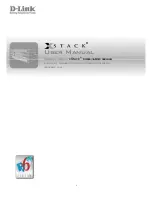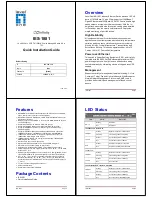
Description of Hardware
5
and the other end to any available RJ-45 port on the switch. All RJ-45 ports
support 10Mbps and 100Mbps Ethernet or Giga Ethernet connections. When
inserting an RJ-45 plug, be sure the tab on the plug clicks into position to
ensure that it is properly seated. Using the switch in a stand-alone
configuration, you can network up to 8 end nodes.
Caution:
Do not plug a phone jack connector into any RJ-45 port. This may damage the
switch. Instead, use only twisted-pair cables with RJ-45 connectors that
conform with FCC standards.
Notes:
1.
When connecting to another compatible switch or hub, run straight-through
cable between MDI (daisy chain) and MDI-X (station) ports. You may also
attach to MDI-X (station) ports at both ends if you use crossover cabling.
(Refer to “Port and Cable Assignments” on page 8 for a description of
crossover cable).
2.
Make sure each twisted-pair cable does not exceed 100 meters (328 feet).
3.
We advise using Category 5 cable for all network connections to avoid any
confusion or inconvenience in the future when you upgrade attached devices
to Fast Ethernet.
Restrictions on Cascade Length
- The IEEE 802.3 standard recommends restricting
the number of hubs (i.e., repeaters) cascaded via twisted-pair cable to 4; while IEEE
802.3u provides even stricter recommendations for Fast Ethernet. Therefore, when
cascading devices other than this switch, please refer to the accompanying
documentation for cascade restrictions. However, note that because switches break up
the path for connected devices into separate collision domains, you should not include the
switch or connected cabling in your calculations for cascade length involving other devices.
Powering On the Switch
1.
Plug the power cord into the power socket on the rear of the switch, and the
other end into a power outlet.
2.
Check the LED marked Power on the front panel to see if it is on. The unit will
automatically select the setting that matches the connected input voltage.
Therefore, no additional adjustments are necessary when connecting it to any
input voltage within the range marked on the rear panel.
3.
The switch performs a self-diagnostic test upon power-on. (Note that this test
takes several minutes to complete.)
Note:
The unit supports a “hot remove” feature which permits you to connect or
disconnect twisted-pair or fiber cables without powering off the switch and without
disrupting the operation of the devices attached to the switch.




























